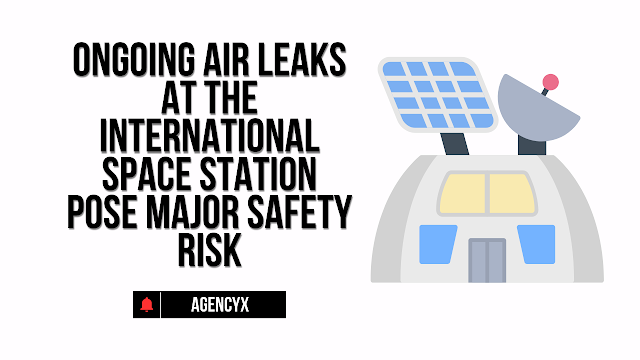The International Space Station (ISS) is once again in the spotlight, not for a groundbreaking scientific discovery but due to a pressing safety concern. A recently published NASA report highlights that an ongoing air leak at the ISS has escalated into a "top safety risk." This leak, which NASA has been monitoring for some time, has reached its highest severity in 2024, raising concerns for the safety of astronauts on board.
The September 26 report, issued by NASA’s Office of Inspector General, was signed by Deputy Inspector General George A. Scott. It detailed how the leak, originating from the tunnel connecting the Russian segment of the ISS to a docking port, is now a growing issue. While this problem has been discussed before, the report brings to light that recent developments in the leak’s progression have intensified NASA’s and Roscosmos’s (Russia's space agency) efforts to find a solution.
Leak Location and Risk Assessment
The leak specifically stems from the Service Module Transfer Tunnel, a critical structure that allows access to the ISS’s Russian segment. According to NASA and Roscosmos, they are "working together to address structural issues" within this section of the station. Despite joint efforts, the agencies have not yet reached a consensus on the point at which the leak rate will become "untenable"—a point where it could significantly jeopardize crew safety and operations.
In earlier communications, Russia downplayed the threat, stating in February that the issue posed no immediate danger to astronauts. However, in the most recent update from NASA, they disclosed that by April 2024, the leak rate had increased to its highest level yet. Concerns within both agencies grew over the months of May and June, as ISS Program and Roscosmos officials convened to discuss the leak’s troubling upward trend.
As of August 2024, the Service Module Transfer Tunnel's leak was scored as a "5 by 5" on NASA’s risk scale. This scoring system evaluates risks based on two factors: "risk likelihood," or the probability of the event occurring, and "risk impact," meaning the potential damage or harm resulting from the issue. A score of 5 is considered "most severe" on both counts, making this leak a critical concern for the ongoing operations of the International Space Station.
Contingency Plans and Immediate Actions
In response to the rising leak rate, NASA and Roscosmos have put several precautionary measures in place. One option currently being explored is the permanent closure of the affected tunnel. This step, while necessary if the leak worsens, would have major operational consequences. The closure would effectively cut off one of the four docking ports for the Russian segment, potentially hindering the space station’s capabilities for incoming missions and supplies.
For the time being, the ISS crew has been closely monitoring the leak and temporarily sealing the tunnel when it is not in use. While this is only a temporary fix, it allows NASA and Roscosmos more time to assess the situation and come up with a long-term solution to prevent further complications.
As the ISS remains operational, set to stay active until 2030, NASA is continuing to work closely with Roscosmos to mitigate the risks posed by this structural issue. Meanwhile, Russia has committed to remain on the ISS until 2028, after which they plan to focus on building a new space station. NASA, on the other hand, is expected to partner with private space company SpaceX to safely deorbit the ISS once its mission comes to an end.
Future Concerns and Recommendations
In addition to addressing the immediate threat posed by the leak, NASA’s report offered recommendations to improve safety and contingency planning aboard the ISS. One of the main points is the need for NASA to reexamine its tools for tracking orbital debris, which could potentially exacerbate the current structural damage or create new risks for the crew.
With the increasing presence of space debris in low Earth orbit, monitoring and managing the risk of collision is becoming more crucial than ever. In light of the ISS’s current air leak issue, such precautions are paramount to ensuring the long-term safety of the astronauts aboard the International Space Station.
NASA also emphasized the importance of documenting contingency plans in the event that the air leak reaches an untenable level. These plans should include clear steps for evacuating crew members, maintaining the station’s functionality, and addressing potential damage caused by the leak. Preparing for such scenarios could mean the difference between life and death for the astronauts currently residing on the ISS.
The Future of the International Space Station
The ISS has been an essential hub for scientific research and international collaboration since its inception. As a joint project between NASA, Roscosmos, and other space agencies, the ISS has provided invaluable contributions to our understanding of space, medicine, physics, and a variety of other fields. However, as the station approaches the final decade of its operation, incidents like the current air leak demonstrate the inherent risks involved in maintaining a structure that has been in continuous use for over two decades.
NASA’s report underscores the importance of taking immediate and effective action to address this pressing safety concern. While Roscosmos remains confident that they can monitor and close the affected tunnel before the leak rate becomes untenable, the growing severity of the problem suggests that a more permanent solution may be necessary sooner than later.
As space agencies around the world continue to push the boundaries of space exploration, ensuring the safety of astronauts aboard international missions remains a top priority. For now, all eyes are on NASA and Roscosmos as they work to contain the air leak and safeguard the future of the International Space Station.
Keywords: international space station, international space centre, international satellite station, international space satellite, international space ship, international space shuttle






.png)
.png)

.png)
0 Comments